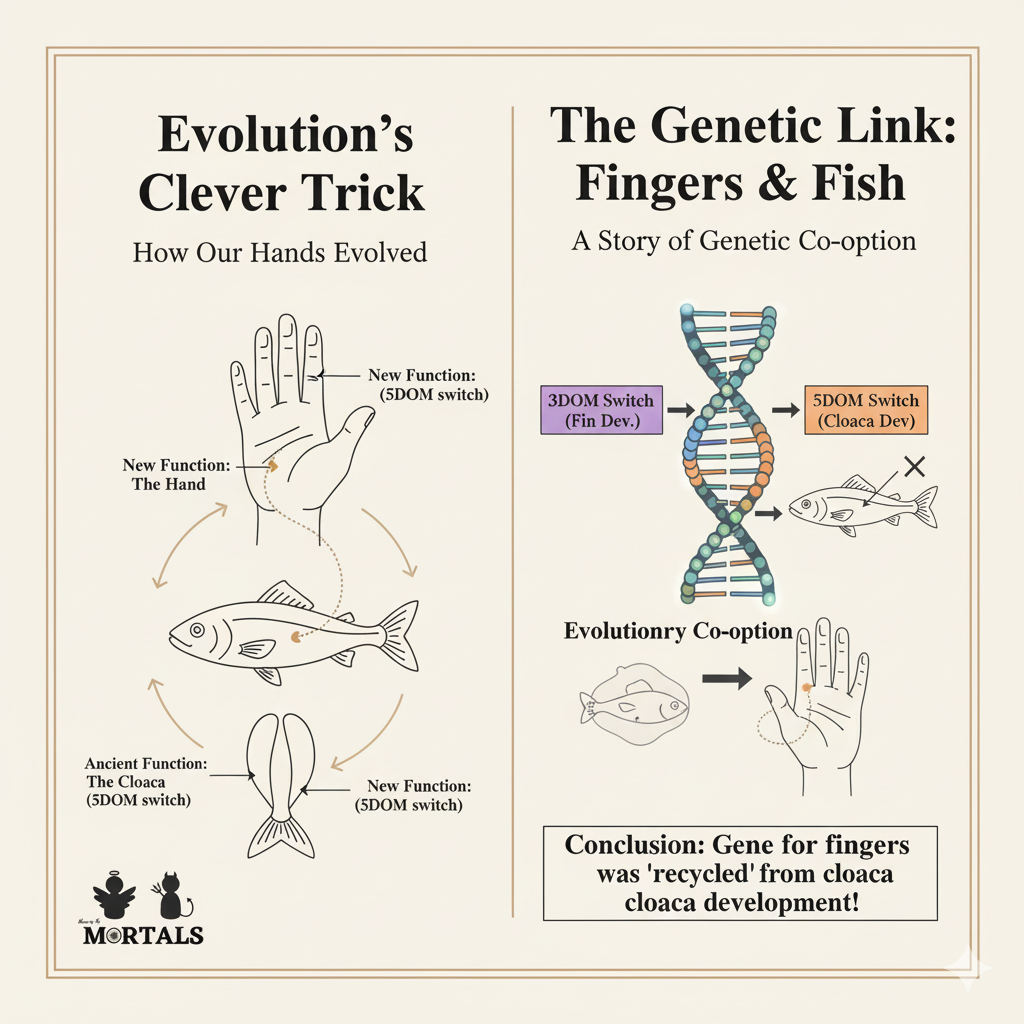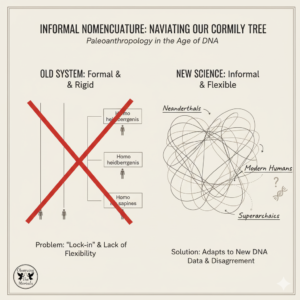The human hand, with its intricate fingers and opposable thumb, is a symbol of our unique evolutionary journey. The story of how it evolved from the simple fin of our fishy ancestors is one of the great epics of natural history. For decades, a key puzzle has been how the same basic set of genes (Hox genes) could build both a simple fin and a complex hand. A groundbreaking new study published in Nature provides a stunning and unexpected answer. The genetic secret to our fingers, it turns out, lies not in the fin itself, but in a completely different and much more primitive part of the fish’s body: its cloaca.
The Information Box
Syllabus Connection:
- Paper 1: Chapter 9.4 (Human DNA profiling, gene mapping and genome study), Chapter 1.4 (Principles of Evolution), Chapter 9.1 (Human Genetics)
Key Concepts/Tags:
- Evolutionary Developmental Biology (Evo-Devo), Hox Genes, Gene Regulation, Fins-to-Limbs Transition, Co-option, Deep Homology
The Setting: Who, What, Where?
This case study is based on a major study by an international team of scientists who were investigating the deep genetic origins of limbs. Their research used two key model organisms: the zebrafish, representing the ancestral finned state, and the mouse, representing the modern limbed state. The scientists focused on the HoxD gene cluster, which is crucial for building appendages, and two key DNA regions that act as “on-off” switches for these genes, known as 3DOM and 5DOM. The key anatomical structures in question were the fin, the limb, and the cloaca—the common opening for digestive and reproductive systems in fish.
The Core Argument: Why This Study Matters
This study provides a specific and elegant genetic mechanism for one of the most important transitions in evolutionary history.
- Solving the Puzzle of Shared Genes: The research started with a paradox: both fish and land animals have similar HoxD genes, so why do they build such different appendages? The answer, scientists suspected, lay not in the genes themselves, but in how they are regulated.
- The Discovery of a “Co-opted” Switch: The experiments with zebrafish revealed a huge surprise. While the 3DOM genetic switch was indeed ancient and involved in fin development, the 5DOM switch had a different job. Deleting it had little effect on the fin, but it disrupted the development of the cloaca. In parallel studies on mice, they found that this same 5DOM switch was crucial for developing the urogenital system (which evolves from the cloaca).
- Evolution as a Thrifty “Tinkerer”: This is the revolutionary insight. The genetic machinery that is essential for building our fingers today was co-opted from another, much older job. Evolution didn’t invent a brand-new genetic program to create fingers. Instead, it took an existing program—the one for building the cloacal region—and repurposed it for a new function in a new location: the tip of the developing limb bud. This is a perfect example of evolution working like a thrifty tinkerer, recycling old parts for new inventions.
The Anthropologist’s Gaze: A Critical Perspective
- The Power of “Evo-Devo”: This case study is a prime example of the field of Evolutionary Developmental Biology (Evo-Devo). This field has transformed our understanding of evolution by showing that major changes in animal bodies are often caused not by the evolution of entirely new genes, but by simple changes in gene regulation—that is, changing when and where existing genes are turned on and off during an embryo’s development.
- A Window into “Deep Homology”: This is a textbook case of deep homology. This concept explains how seemingly unrelated and very different body parts (like a hand and a cloaca) can share a deep, ancient, and hidden genetic regulatory network. It reveals the underlying unity and powerful economy of the genetic toolkit that is shared by all vertebrates.
- The “How” vs. The “Why”: A critical perspective would note that this study brilliantly explains the genetic mechanism (the “how”) of this major evolutionary innovation. The next scientific question, which this study does not address, is the evolutionary pressure (the “why”). What specific environmental challenges or opportunities favored the re-deployment of this particular genetic pathway to elaborate the fin, eventually leading to limbs that could bear weight and walk on land?
The Exam Angle: How to Use This in Your Mains Answer
- Types of Questions Where It can be Used:
- “Discuss the principles of evolution, focusing on the genetic basis of change.”
- “Analyze the significance of the fin-to-limb transition in human evolution.”
- GS-3 (Science & Tech): “How are modern genetic studies changing our understanding of evolution?”
- Model Integration:
- On Evolutionary Principles: “A key principle of evolution is ‘co-option,’ where existing genetic pathways are repurposed for new functions. A remarkable recent study on Hox genes showed that the ‘5DOM’ genetic switch, which is crucial for building human fingers, was originally used to develop the cloaca in our fish ancestors, demonstrating how evolution tinkers with old parts to create new structures.”
- On the Genetic Basis of Evolution: “Modern genetics reveals that major evolutionary changes often result from changes in gene regulation rather than entirely new genes. The discovery that the HoxD gene’s function was modified by co-opting the ‘5DOM’ regulatory region from the cloaca to the limb is a perfect example of how altering a gene’s ‘on-off’ switch can drive the evolution of new body parts.”
- For a GS-3 Answer: “Our understanding of evolution is being transformed by fields like Evo-Devo. Recent research using zebrafish has revealed the surprising genetic link between the development of the reproductive/digestive tract and our fingers, showing that the genetic toolkit for our hands was recycled from an ancient gene program that existed millions of years ago.”
Observer’s Take
The story of evolution is full of surprising twists, and this is one of its most elegant. The idea that the genetic blueprint for our hands—the very feature we associate with our unique human capabilities—was borrowed from a primitive, multi-purpose opening in our distant fish ancestors is both a humbling and powerful revelation. It is a perfect example of evolution’s practical, thrifty genius: it doesn’t invent what it doesn’t have to. This discovery is a profound reminder that the story of our own bodies is a complex and beautiful mosaic, built from ancient, shared, and cleverly recycled parts.





